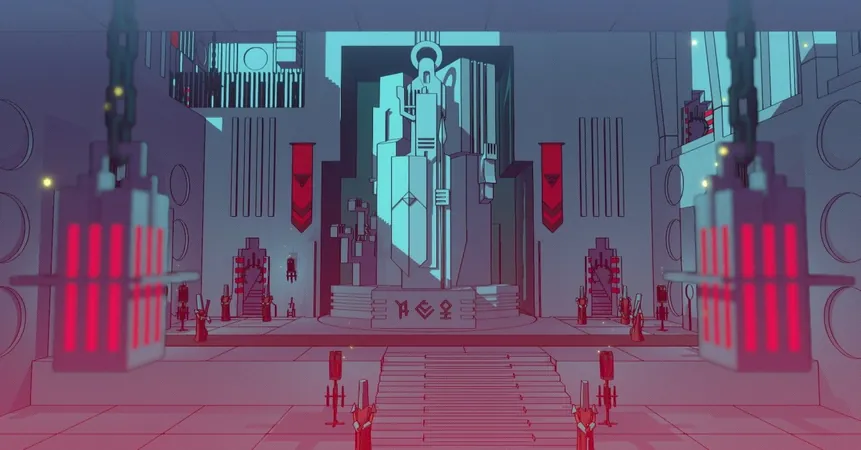
Unlocking the Secrets: How Indie Games Attract Their First 1,000 Players
2025-01-12
Author: Ming
In the fast-paced world of video game development, especially for indie developers with tight budgets, the challenge of attracting an initial player base can seem daunting. With a plethora of games launching every week, how can a new title break through the noise and connect with players? The answer often lies within the intricate web of player discovery.
While many attribute the success of breakout indie games to the influence of streamers and YouTubers, there's a compelling argument that the most significant player discovery platform, particularly for PC games, is none other than Steam itself. Valve's digital storefront acts not just as a marketplace but also as a powerful discovery engine fueled by algorithms designed to elevate games based on their performance metrics.
For game developers, the battle to secure visibility starts with their performances on Steam. Metrics indicating traffic sources — whether from external websites, direct searches, or organic Steam promotions — are crucial. These promotions include features like the Discovery Queue and "More Like This" placements, which serve as vital ad slots. What's remarkable is that developers cannot simply purchase these slots; they earn them through strong sales performances, positive reviews, and player engagement.
Take the recent success of *Omega Strikers*, for example. According to Ryan Rigney, a marketing veteran in the gaming industry, an impressive 70% of the game’s store traffic originated from Steam's own promotions, demonstrating the platform’s capacity to propel visibility. This highlights the intricate relationship between organic traffic and a game’s ultimate success, as evident through the experiences of several successful indie developers.
Diverse Paths to Success
In an exploration of how various indie games find their early adopters, we surveyed several developers, each of whom carved out profound pathways to obtaining their first 1,000 players. Here are some illuminating insights and strategies they've employed.
1. TikTok Success with *Loddlenaut*
Ricardo Escobar, co-founder of the eco-conscious game *Loddlenaut*, credits the first wave of sales to an impressive wishlist conversion on Steam, bolstered by their popular TikTok account which generated viral posts. The game, which centers on cleaning oceans and nurturing adorable alien creatures, launched with around 55,000 wishlists and benefited immensely from being featured during Steam events. The pivotal moment arrived when *Loddlenaut* secured a spot on Steam's "New & Trending" tab, thanks to positive player engagement and strong metrics, propelling it into discovery rankings.
2. Breaking Out with *Chants of Sennaar*
Julien Moya of Rundisc celebrated their puzzle game *Chants of Sennaar*, noting that launching it alongside major titles like *Starfield* inadvertently boosted visibility due to a lack of competition. This strategic timing, combined with a demo release and favorable press coverage, catapulted the game into player consciousness. As Moya states, strong player reviews created a ripple effect, leading to hundreds of thousands of sales as critical acclaim spread through word-of-mouth and media buzz.
3. Emotional Impact with *Lil Gator Game*
Connor P. Quinn, director of *Lil Gator Game*, emphasizes the emotional resonance of their game, which quickly attracted early players. The team employed traditional marketing tactics such as social media engagement and partnerships with streamers. The heartfelt gameplay experience led to numerous players making emotional declarations of love for the game, which subsequently turned into viral content—driving fresh waves of players eager to see for themselves what the hype was all about.
4. Niche Champion with *SKALD: Against the Black Priory*
Anders Lauridsen, the mastermind behind *SKALD*, identifiers how meticulous positioning targeted at a niché audience was paramount. By building a community and capitalizing on social media to increase wishlists, along with support from a publisher who handled promotional tactics effectively, Lauridsen ensured that *SKALD* hit the ground running. He also underscored the importance of creating a standout product to attract attention from industry veterans and media alike.
Conclusion: Unlocking the Formula for Success
To distill the insights from these indie developers, here are key takeaways for emerging game creators striving to capture their first 1,000 players:
- **Leverage Steam’s Algorithm**: Prioritize earning visibility on Steam through strong sales and reviews.
- **Build Community and Buzz Early**: Engage on social media and create excitement pre-launch through wishlists and demos.
- **Focus on Emotional Engagement**: Develop games that resonate with players on a personal level—they're more likely to share their experiences.
- **Target Your Audience**: Understand and communicate with your niche market, ensuring your messaging is tailored.
- **Capitalize on Critical Moments**: Timing your release and leveraging events, demos, and influencer partnerships can significantly boost visibility.
The journey to a thriving player base begins with the first steps taken in the intricate labyrinth of game discovery—and these developers show that with the right strategies, hitting that milestone is entirely achievable. Who knows? Your game might just be the next one to capture players' hearts!


 Brasil (PT)
Brasil (PT)
 Canada (EN)
Canada (EN)
 Chile (ES)
Chile (ES)
 Česko (CS)
Česko (CS)
 대한민국 (KO)
대한민국 (KO)
 España (ES)
España (ES)
 France (FR)
France (FR)
 Hong Kong (EN)
Hong Kong (EN)
 Italia (IT)
Italia (IT)
 日本 (JA)
日本 (JA)
 Magyarország (HU)
Magyarország (HU)
 Norge (NO)
Norge (NO)
 Polska (PL)
Polska (PL)
 Schweiz (DE)
Schweiz (DE)
 Singapore (EN)
Singapore (EN)
 Sverige (SV)
Sverige (SV)
 Suomi (FI)
Suomi (FI)
 Türkiye (TR)
Türkiye (TR)
 الإمارات العربية المتحدة (AR)
الإمارات العربية المتحدة (AR)